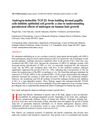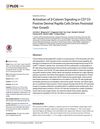TLDR Ecklonia cava, a type of seaweed, may help hair grow.
In December 2013, a study found that Ecklonia cava, a brown marine alga, and its component dioxinodehydroeckol have hair growth-promoting effects. The ethyl acetate-soluble fraction of E. cava (EAFE) significantly increased the proliferation of human dermal papilla cells (DPCs) and outer root sheath (ORS) cells, elongated the hair shaft in cultured human hair follicles, and induced the anagen phase in mice hair cycles. EAFE also increased insulin-like growth factor (IGF)-1 expression in DPCs. Dioxinodehydroeckol alone also promoted hair shaft elongation, cell proliferation, and upregulated IGF-1 expression in DPCs. These results suggest that E. cava and dioxinodehydroeckol could be potential candidates for hair-care and hair-growth cosmetic products due to their ability to stimulate cell proliferation and IGF-1 expression. The specific number of subjects used in the study was not mentioned.
 171 citations
,
July 2007 in “Journal of Investigative Dermatology”
171 citations
,
July 2007 in “Journal of Investigative Dermatology” A substance called DKK-1 increases in balding areas and causes hair cells to die when exposed to DHT.
 190 citations
,
October 2002 in “The FASEB journal”
190 citations
,
October 2002 in “The FASEB journal” Androgens may cause hair loss by increasing TGF-beta1 from scalp cells, which inhibits hair cell growth.
 78 citations
,
August 2002 in “Experimental Dermatology”
78 citations
,
August 2002 in “Experimental Dermatology” Researchers developed a quick and easy way to get and grow cells from the base of human hair follicles.
56 citations
,
June 2002 in “Biomaterials” Controlled release of VEGF in a collagen hydrogel boosts hair growth in mice.
 26 citations
,
July 2016 in “PLOS ONE”
26 citations
,
July 2016 in “PLOS ONE” Activating β-catenin in certain skin cells speeds up hair growth in mice.
 April 2016 in “Journal of Investigative Dermatology”
April 2016 in “Journal of Investigative Dermatology” Wnt ligands, produced by dermal papilla cells, are essential for adult hair growth and regeneration.
 10 citations
,
February 2016 in “Journal of Dermatological Science”
10 citations
,
February 2016 in “Journal of Dermatological Science” Skin sheath cells help in hair growth and renewal after birth.
95 citations
,
July 2006 in “British Journal of Dermatology” Vitamin D receptors in hair follicles change with the hair cycle, affecting hair growth.
 27 citations
,
November 2005 in “Archives of Dermatological Research”
27 citations
,
November 2005 in “Archives of Dermatological Research” Choosing hair follicles at the same growth stage leads to more consistent hair growth experiments.
 56 citations
,
July 2005 in “Experimental Dermatology”
56 citations
,
July 2005 in “Experimental Dermatology” Injected human hair follicle cells can create new, small hair follicles in skin cultures.
154 citations
,
October 1996 in “Proceedings of the National Academy of Sciences of the United States of America” Estrogen affects hair growth and skin cell multiplication.








